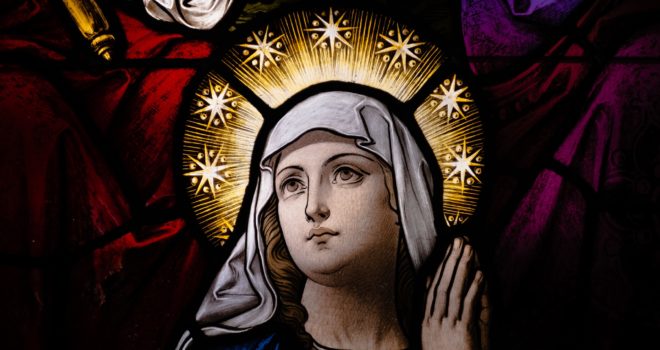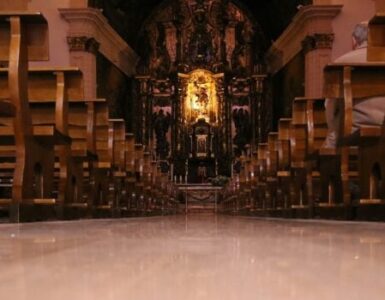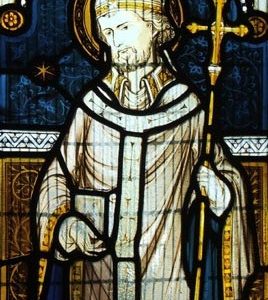The Virgin Mary appeared to a would-be papal assassin — an encounter that changed his life. This unexpected meeting with the Mother of God and the special grace he received freed him from the noose of evil and gave him strength to live according to divine teaching.
In 1937, Luigina Sinapi had an extraordinary vision. The Holy Mother appeared to her, announcing that she would convert the man who planned to assassinate the pope. Luigina was to inform Cardinal Pacelli that he would succeed Pope Pius XI. The visionary met with him and told him about the amazing announcements from the Mother of God, but the cardinal kept their conversation to himself.
Two years later, Pacelli was indeed elected pope. One part of the Marian prophecy had come true. What about the rest? Ten years later, in 1947, the Virgin appeared in Tre Fontane, Rome, thwarting an attempt on the pope’s life.
Tre Fontane, 1947
Bruno Cornacchiola was born in 1913, and from an early age he had a bad reputation. An unappealing character in every way, he held the title of “master of gutter talk.” Known for fighting and brawling, he had numerous ties with the criminal world. He fought for the Communists during the Spanish Civil War.
Under the influence of a German Protestant, Cornacchiola became convinced that the papacy was the source of all evil in the world. Inflamed with hatred for the Catholic Church, he vowed to kill the Holy Father. These were not empty words. While still in Spain, he purchased a dagger on which he carved “Death to the Pope.” He even determined the day of the attack: September 8, 1947 — the Nativity of Mary. He soon became famous for his propaganda attacks on the Church, the pope, and Marian dogmas.
Nine First Fridays
Bruno was married; however, he was far from an exemplary husband. After returning from the war, he destroyed everything in his home that reminded him of the Catholic faith and ordered his wife to abandon the faith. Eventually, Jolanda agreed to join the Adventists, but on one condition: that Bruno practice nine First Fridays of the month. If afterward he continued to stand by his decision, she would give way.
It’s strange, but Cornacchiola agreed and practiced the First Friday devotions, as revealed to St. Margaret Mary Alacoque. Jolanda believed that God would somehow convert her husband. Unfortunately, nine months passed and Bruno continued to burn with hatred for the Church. With internal reluctance, the wife of Cornacchiola joined the Adventists.
Persecutor of the Mother of God
On April 12, 1947, God was to show that He is faithful to His promises, although graces are not always granted in the time frame expected.
That year, Cornacchiola was a tram driver in Rome and a staunch Communist. On the first Saturday after Easter, he and his three children went for a picnic in Tre Fontane — specifically, in the forest in front of the famous basilica that commemorates the site of the martyrdom of St. Paul the Apostle. The name Tre Fontane is tied to a certain legend: when the Apostle to the Nations was decapitated, it was said that his head bounced on the ground three times, and in those places three fountains emerged. Hence, Tre Fontane is also called the Fountains of the Holy Trinity.
Near Tre Fontane was a Trappist monastery, and next to it was a well-known chocolate shop. They waited for it to open. Cornacchiola sat down in the shade of a eucalyptus tree and prepared a speech ridiculing the dogma of the Immaculate Conception. His hatred for the Mother of God was so great that, earlier the same day, he had defaced a statue of Mary. The statue’s pedestal bore the inscription Vergine Madre, or Virgin Mother. Cornacchiola wrote: “You are neither a virgin nor a mother.”
Meanwhile, the children were playing with a ball. At 3:20, they called him to help them look for the ball. A moment later, the father was no longer looking for a ball, but for his four-year-old son. He found him in a small grotto, kneeling
with his hands folded and repeating, “Beautiful lady! Beautiful lady!” The other children came running and knelt beside their brother. They also saw a beautiful figure in the grotto. Bruno tried to lift the children, but they were as heavy as lead. Enraged, he started screaming into the empty grotto. Finally, in his helplessness, he unconsciously recalled the words from his childhood: “Lord, help me!”
Paul’s Conversion
At that same moment, Cornacchiola saw two transparent hands, which touched his face and rubbed his eyes and caused severe pain. After a moment he saw a small light in the grotto that grew stronger and stronger. It blinded him, though he felt incomprehensible joy in his heart.
When he was able to see again, a beautiful woman stood before him, full of tenderness and sorrow. She was wearing a green mantle and, under it, a white dress with a red belt. In her hands she held a gray book that she pressed to her chest. A broken crucifix lay at her feet.
A year later, Bruno was to place the following inscription at the entrance to the grotto:
“Here in this grotto, a hotbed of sin, I, a sinner, on my horse of hatred, immersed in darkness, was ready to fight against the dogma of the Immaculate Conception established by the Church, our Mother. She herself came and threw me down from the horse and won. Taking pity on me in her maternal love, she spoke and told me, ‘You persecute me; enough now!’ At that same moment, Jesus, who is the Way, the Truth and Life came into me.”
Clearly, Cornacchiola was aware of the similarities between his own conversion and the conversion of St. Paul.
“Of the Trinity”
Mary introduced herself to Cornacchiola as the “Virgin of Revelation.” Scholars believe this title has at least two meanings. First, it calls on the Church to teach about the Blessed Virgin Mary based on Scripture. Indeed, Mary appeared to Cornacchiola holding a Bible. Second, the title points to Mary as the woman from the Book of Revelation, where she is actively involved in the last chapters of human history.
The Virgin of Revelation spoke to Bruno for nearly an hour and a half, talking to him in a calm, rhythmic voice. Cornacchiola remembered every word exactly as she had said them to him. Mary announced, “I am the one who is of the Divine Trinity. … I am Daughter of the Father, Mother of the Son, and the Spouse and Temple of the Holy Spirit.”
Then, she told him, “I am the Virgin of the Revelation. You persecute me, but enough of this! Come and be part of the holy flock, which is the heavenly kingdom on earth.” Mary emphasized the importance of traditional forms of Catholic piety: First Friday devotions, the Rosary, and praying the Ave Maria. She said,
“God’s promises are and will remain unchanged. The nine First Fridays in honor of the Sacred Heart, which your faithful wife persuaded you to observe before you walked down the road of lies, has saved you. … The Hail Marys which you pray with faith and love are like golden arrows that directly reach the Heart of Jesus. … Pray a great deal, recite the Rosary, and pray for the conversion of sinners, for nonbelievers and for all Christians.”
The Holy Mother also called for unconditional obedience to the Church: “You must be like the flowers which
Isola [his ten-year-old daughter] picked. They make no protest; they are silent and do not rebel.”
Marian Appeals
The Mother of God bound the site of her apparition with a special grace. A notorious area known as a place
for illicit trysts, it was to become a tool of grace. “With this sinful soil,” Mary announced, “I will perform great miracles for the conversion of nonbelievers and sinners.” Mary called Bruno to “Live according to divine teachings. Practice the
Christian faith. Live it.” Simply professing faith using lips is not yet a journey of faith — to Heaven, to God, to eternal happiness.
She placed a great deal of importance on her Assumption. For eighty minutes, she taught Cornacchiola about her life. She said, “My body could not decay and did not decay. I was taken to Heaven by My Son and angels.” After delivering a secret message to Cornacchiola reserved for the pope only (the visionary conveyed it to the Vatican on May 6, 1947), she advised,
“You must go to the Holy Father, the pope, the Supreme Pastor and personally tell him my message. Bring it to his attention. I shall tell you how to recognize the one who will accompany you to see the pope.”
The vision came to an end. The Holy Mother smiled at Bruno and the three children, then turned and walked through the walls of the grotto. Cornacchiola was in shock. Together with the children, he went into the Trappist church to thank God for what had just happened to him. Next, he returned to the grotto, where there was a waft of perfume in the air — strange, since the park grounds were littered with filth.
When Bruno came home, Jolanda smelled a strange scent. When the children went to sleep, the repentant husband told her everything that had happened. He fell at her feet and begged her to forgive him.
Meeting With the Pope
As ordered by Mary, Cornacchiola found the priest who became his spiritual director — and who would eventually help to arrange his meeting with Pope Pius XII. Bruno and Jolanda returned to the Catholic Church. News of the apparition of the Virgin in Tre Fontane spread like wildfire, and numerous pilgrimages set off to the grotto. The police even questioned Bruno and his children. Yet when interrogated separately, they all said exactly the same thing.
A similar examination was carried out by Church authorities, and devotion to the Virgin of Revelation was approved
very quickly. On October 5, a month after the planned assassination attempt on his life, Pius XII consecrated a representative figure of Mary from the apparition in the grotto. It was carried from St. Peter’s Square to Tre Fontane in a huge procession.
Two years later, on December 9, 1949, Bruno found himself included in the group of people invited to the pope’s private chapel to pray the Rosary with Pius XII. After the devotion, the Holy Father asked if anyone would like to talk to him. In a fraction of a second, Cornacchiola was kneeling before him, crying and showing Pius the dagger with which he had intended to kill him. He asked for forgiveness, which he immediately received. “My dear son,” Pius said, “by doing that, you would have added a new martyr to the Church and a new pope!”
An Incomplete Apparition?
In 1956, the Conventual Franciscans became the guardians of the grotto. They were the ones who built the chapel on the site of the apparition. The prayer to the Virgin of Revelation received an imprimatur, and the devotion was so widespread that during the Second Vatican Council many bishops came there to pray. In 1987, on the fortieth anniversary of the apparition at Tre Fontane, Cardinal Ugo Poletti, as official representative of the pope, marked the occasion with a special Mass.
The Church has not delivered a final judgment on the apparition, mainly because of suspicions that the visionary had lost his credibility. He maintained that he had received twenty-eight other apparitions. The tone of these messages become more and more apocalyptic, and they never came true. But no one could deny the depth and sincerity of Bruno Cornacchiola’s conversion, which almost seems a miracle in itself.
✠
Editor’s note: This article is adapted from a chapter in the book The World of Marian Apparitions: Mary’s Appearances and Messages from Fatima to Today. It is available from your favorite bookseller or online through Sophia Institute Press.
Photo by Levi Meir Clancy on Unsplash













